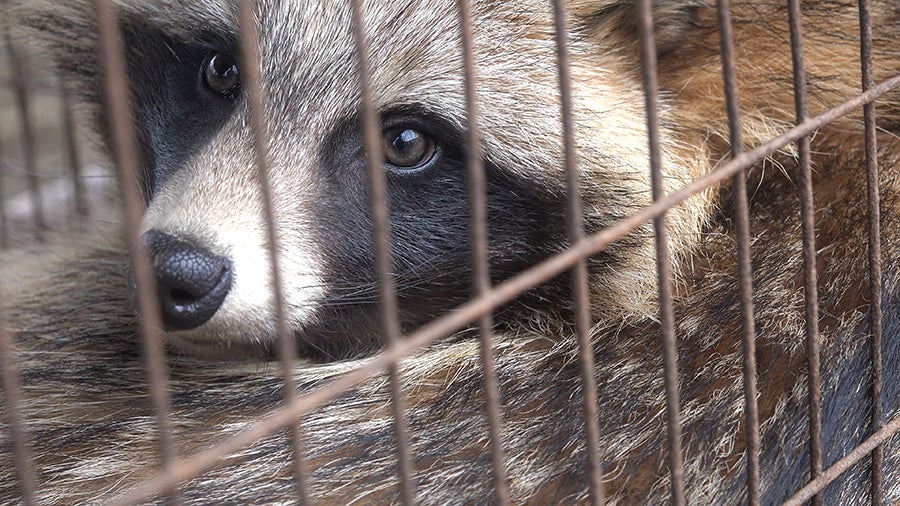
Each year, around 37 million animals in the European Union are still raised and killed solely for their fur. In 2018 alone, 34.7m mink, 2.7m foxes, 166,000 raccoon dogs and 227,000 chinchillas were bred in the EU. Denmark, Finland, Poland and the Netherlands (which is currently phasing out the industry) are the biggest European fur producers.
Fur farming bans
The good news is that various EU Member States have already taken legislative action to ban and phase out fur farming because this practice is inherently inhumane.
Austria, the Netherlands, Belgium, Luxembourg, Slovenia, Croatia, Czech Republic, Slovakia and the departing UK have already done so, while Ireland is in the process of passing a ban on fur production, and legislative proposals have recently been introduced in Bulgaria, Lithuania and Estonia.
Even in Denmark – the bastion of the European fur industry – fox farming has been banned and is being phased out on animal welfare grounds, although regrettably mink farming continues there.
While Germany has not enacted a fur farming ban, it has introduced stringent welfare conditions that have rendered the industry economically unviable, and all remaining fur farms in the country have closed down. Just beyond the EU borders, Norway, Serbia, the Republic of Macedonia and Bosnia and Herzegovina have also banned fur production.
Why HSI believes that fur farming should be banned
The main species of animals – mink and foxes – reared in fur factory farms are still essentially wild animals still not selected for tameness or adaptability to captive environments.
These animals spend short and miserable lives in small wire cages, only to be gassed or electrocuted to death when their pelts are at their prime. We believe that it is unethical to keep animals and kill animals in this way for frivolous fashion purposes. There should be no place for fur farming in an EU that cares about animals.
Animal welfare issues
The inherently poor quality of animal welfare on fur farms is a key reason why fur production should be banned.
Mink and fox are carnivores, predators and highly inquisitive, active animals with complex social lives. Unlike most other types of farm animals, which tend to be flock or herd species, mink are solitary by nature. Mink and fox are both territorial and, in the wild, go to great lengths to defend their territories. These animals are unsuited to farming conditions and suffer great stress from intensive breeding and rearing.
Kept in small wire cages, animals on fur farms exhibit stereotyped behaviour (pacing along the cage wall, repetitive circling, head nodding, etc.) and self mutilation (e.g. sucking or biting tail fur or other parts of the pelts). There is also a high level of mortality on fur farms.
There is, however, no specific EU legislation providing detailed animal welfare requirements for keeping of animals for fur production. Fur factory farms are covered by Council Directive 98/58/EC, which lays down the general minimum requirements for the protection of all animals kept for farming purposes.
HSI contends that most of these minimum welfare standards are not being met on EU fur farms. Given the physiological and behavioural needs of mink and foxes, the basic housing systems to which they are confined fail to meet the legislative requirements since the animals are unable to express their natural behaviours.
Cage sizes are inadequate, there no provisions for key natural behaviours like a substrate for foxes to dig in or – for the naturally solitary and semi-aquatic mink – any swimming water available, and the animals have no meaningful opportunities to withdraw from the presence of their conspecifics.
The practice of intensively farming animals for their fur is inherently inhumane.
Other environmental and health reasons to ban fur farming
Contrary to industry claims, fur production is far from green. Intensive fur farms produce tonnes of manure, greenhouse emissions, nutrient flows, terrible odors and can attract armies of flies. Waste runoff is a major pollution problem that contaminates soil and waterways.
Fur farming is also a primary pathway for the introduction of invasive alien species, which are a major driver of biodiversity loss. The American mink has long been implicated in the displacement of native mammals such as the European mink and European polecat, the decline of some water vole populations and the drastically decreased breeding success of native ground-nesting birds and domestic fowl.
Significantly, as recent outbreaks of SARS-CoV-2 on mink farms in the Netherlands, Denmark and Spain during the COVID-19 pandemic has highlighted, fur animals can serve as a potential reservoir for dangerous pathogens that can globally threaten human health and the economy. Raccoon dogs and foxes sold in wildlife markets in Asia have also been found to be susceptible to coronaviruses.
What is HSI calling for?
Humane Society International is fundamentally opposed to the exploitation of animals for fur production; it is an unnecessary product for which there are many humane, warm and beautiful alternatives. We are:
- Working with the Fur Free Alliance coalition to end the international fur trade
- Working with global fashion brands and retailers to announce fur-free policies
- Advocating the adoption of fur production bans in Member States where this cruel industry persists
- Calling for the inclusion of the American mink on the EU list of invasive alien species of Union concern
